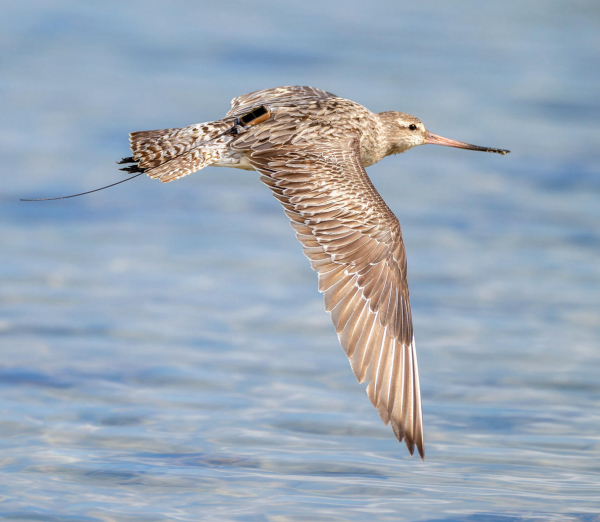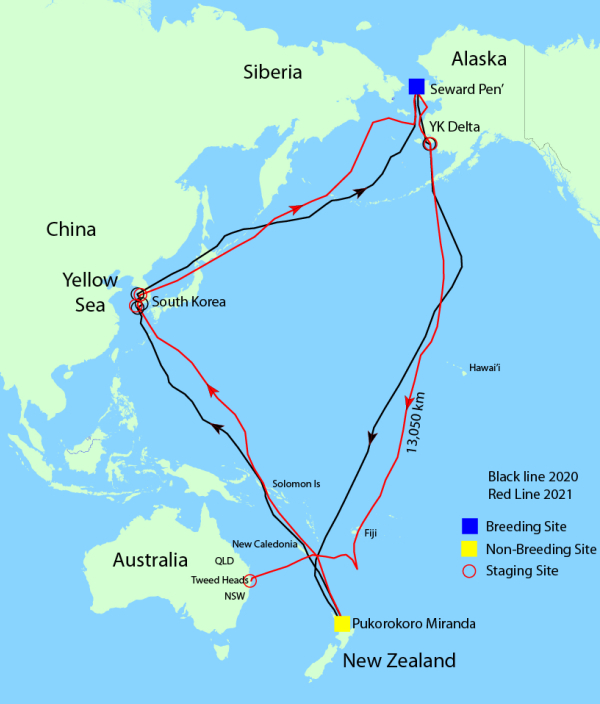
If you look closely, you can see the satellite transmitter and its antennae fitted on the back of the record-breaking Bar-tailed Godwit, photographed a few days ago in western Australia by Geoff White.

A migration map showing the 2020 and 2021 migration routes taken by the record-setting Bar-tailed Godwit (courtesy of Adrian Riegen and Audubon).
|
September 28th an adult male Bar-tailed Godwit completed a record-breaking flight as it touched down in New South Wales, Australia after a continuous migration of more than 8,100 miles that began in western Alaska. The godwit literally flapped its wings for 239 continuous hours to set the world record for the longest continuous flight recorded for any land bird! And the record-setting godwit isn’t done yet – in the next few days, the godwit that is fitted with a solar-powered satellite transmitter is expected to end its migration in New Zealand.
In fact, this same male Bar-tailed Godwit previously held the world record for his 2020 flight of 7,580 miles. But just 3 days before his 2021 touch-down in Australia, a female Bar-tailed Godwit completed a migration of a similar distance that was briefly considered the record flight, which took 8 days and 12 hours at an average speed of 35 miles per hour. “It’s this thing of imagination and magic that we have in this world, to think these birds travel thousands of miles at a time,” exclaimed Audubon Alaska executive director Natalie Dawson.
Although the record-breaking godwit’s migration feat is astounding, it’s not particularly surprising. Bar-tailed Godwits regularly complete ultra-long migrations, with individuals regularly making continuous flights of more than 7,000 miles.
From his home office, Adrian Riegen keeps tabs on the record breaker and 19 other Bar-tailed Godwits fitted with solar-powered transmitters that are tracked using satellites and computer connections. During migration season, Riegan spends at least an hour each morning going through the most recent location data and writes a daily report for the ongoing project, operated by the Pukorokoro Miranda Shorebird Center, an education and research nonprofit centered in Miranda, New Zealand, in the heart of where many Bar-tailed Godwits spend the months away from their nesting range.
Unlike albatrosses or other seabirds known for their long-distance flights, godwits are active flyers, not gliders – their wings are moving the whole time. Riegen related, “I still find it hard to imagine how anything can keep up that sort of effort 24-hours a day without taking a break.”
In Alaska, Bar-tailed Godwits nest in low tundra vegetation adjacent to coastal and estuarine habitats roughly from the Yukon River Delta to the North Slope. Young godwits can fly when they are just 30 days old, and by the end of their first summer, almost all congregate on the mudflats of immense Yukon River Delta to feed in earnest to build up fat reserves. To feed they use their long beaks to pull crustaceans, mollusks, and insects out of sticky mud. “Move, feed; move, feed – always active,” Dawson explained.
When migration time comes, only a few months after hatching, young godwits join yearling and adult godwits to undertake their taxing first migration. Some Bar-tailed Godwits will stopover in New Caledonia or Australia, but many migrate straight to New Zealand. The exact distance traveled varies from flock to flock and individual to individual. The birds make navigational decisions to optimize favorable winds and avoid severe weather, and even just 1/10th of a degree of difference in the starting angle of their migration route could add or subtract mileage to their long-distance flight.
Even with all these variables, godwits are remarkably accurate and consistent, returning to the same sites year after year and setting off on their migrations within a window of just a few days. Riegen related that there is one particular Bar-tailed Godwit that begins migrating north almost exactly on the 25th of March every year, for 13 years!”
When it’s time to return to Alaska in March and April, the Bar-tailed Godwits follow a different migration route, making an initial northbound migration flight to mudflats formed along the shoreline of the Yellow Sea in South Korea, where they feed and rest before continuing northeast to Alaska. This stopover habitat has been rapidly disappearing in recent decades, which was part of the reason the Pukorokoro Miranda tracking project began in 2019, in collaboration with other institutions in New Zealand and abroad. Globally, Bar-tailed Godwit populations have been declining amid growing threats of habitat loss and climate change. Researchers who follow this population want to find out if the birds are adapting to habitat loss and finding other migratory routes. They’re also hoping to understand how young birds move around and select their “wintering” sites in New Zealand.
To refer to the original Audubon article, see https://www.audubon.org/news/
All of the most interesting information about the Bar-tailed Godwit study is disseminated by Riegen to the Center’s followers on Facebook, so birders can follow along with the godwits’ cross-hemisphere, trans-oceanic flights. “It’s such an amazing story,” Riegen said. “We want to share it as widely as we can.” See https://www.facebook.com/MirandaShorebirdCentre